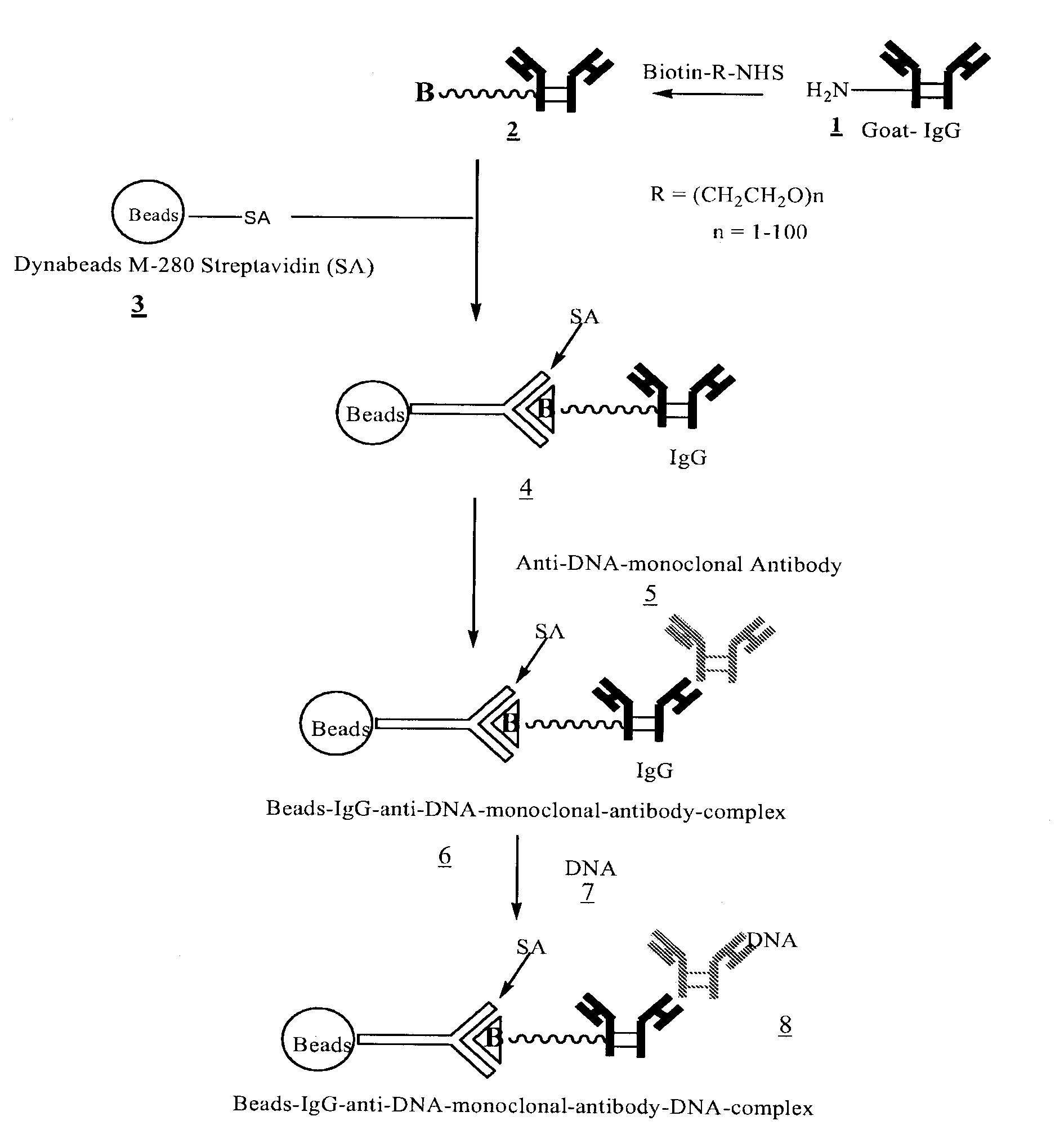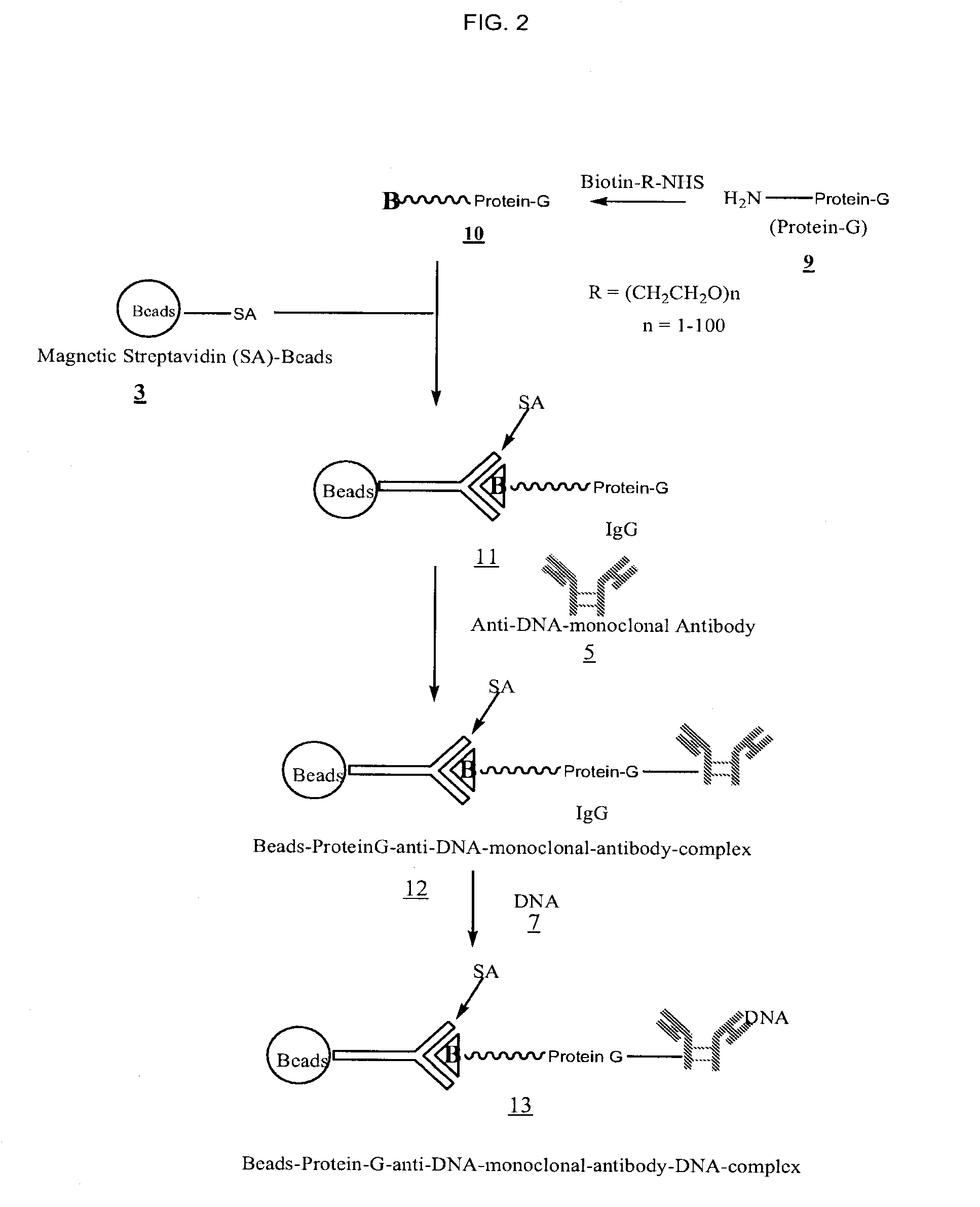Method for isolating cell free apoptotic or fetal nucleic acids
- Summary
- Abstract
- Description
- Claims
- Application Information
AI Technical Summary
Problems solved by technology
Method used
Image
Examples
example 1
Preparation of DNA Binding Beads
[0033]FIGS. 1, 2, and 3 outline the steps involved in preparing magnetic beads conjugated to anti-DNA-antibody through IgG, protein-G and NHS-PEG-Maleimide, respectively.
example 2
Procedure for Isolating Fetal DNA from Maternal Blood
[0034]2 ml maternal blood was treated with anti-DNA-antibody coated beads 6 (FIG. 1), 12 (FIG. 2), or 18 (FIG. 3). Enough beads carrying at least 100 μg of anti-DNA-antibody were used. The sample was gently rotated for 15 minutes at room temperature to ensure thorough mixing of the beads with blood. The sample was then placed in a magnetic separator for 1-2 minutes and the supernatant removed. The beads were then washed three times with 2 M NaCl, 10 mM Tris.HCl, 1 mM EDTA (pH 7.0). The beads were then digested with proteinase K in 200 μl of buffer containing 100 mM NaCl, 10 mM Tris.HCl, 25 mM EDTA, 1% SDS (pH 8.0) at 55° C. for 1 hour. After deactivating proteinase K at 95° C. for 10 minutes, the supernatant was ethanol precipitated by adding 2 volumes of absolute ethanol and chilling the sample at −80° C. for 20 minutes. The DNA pellet was rinsed once with 90% ethanol.
example 3
Gender Determination
[0035]The DNA from Example 2 was used as a template for determining the gender of the fetus using primers and probes in PCR. After rinsing with 90% ethanol, the DNA pellet was dried, dissolved in 80 μl water and analyzed for fetal gender by PCR. Y-chromosome sequences were detected using one or more TaqMan probes, probes that are dual-labeled, 18-22 base oligonucleotide probes with a reporter fluorophore at the 5′-end and a quencher fluorophore at 3′-end, and one or more primers for Y-chromosome sequence markers.
[0036]SRY (Sex-determining Region Y) primers were used to target a sex-determining gene on the Y chromosome, present in humans and other primates. The SRY gene encodes the testis determining factor, which is also referred to as the SRY protein. FCY primers were used to target another common marker in the Y chromosome. The beta-hemoglobin gene, a house-keeping gene that is present in total DNA, was used as an internal control in every PCR reaction. As show...
PUM
| Property | Measurement | Unit |
|---|---|---|
| Fraction | aaaaa | aaaaa |
| Temperature | aaaaa | aaaaa |
| Temperature | aaaaa | aaaaa |
Abstract
Description
Claims
Application Information
 Login to View More
Login to View More - R&D
- Intellectual Property
- Life Sciences
- Materials
- Tech Scout
- Unparalleled Data Quality
- Higher Quality Content
- 60% Fewer Hallucinations
Browse by: Latest US Patents, China's latest patents, Technical Efficacy Thesaurus, Application Domain, Technology Topic, Popular Technical Reports.
© 2025 PatSnap. All rights reserved.Legal|Privacy policy|Modern Slavery Act Transparency Statement|Sitemap|About US| Contact US: help@patsnap.com



